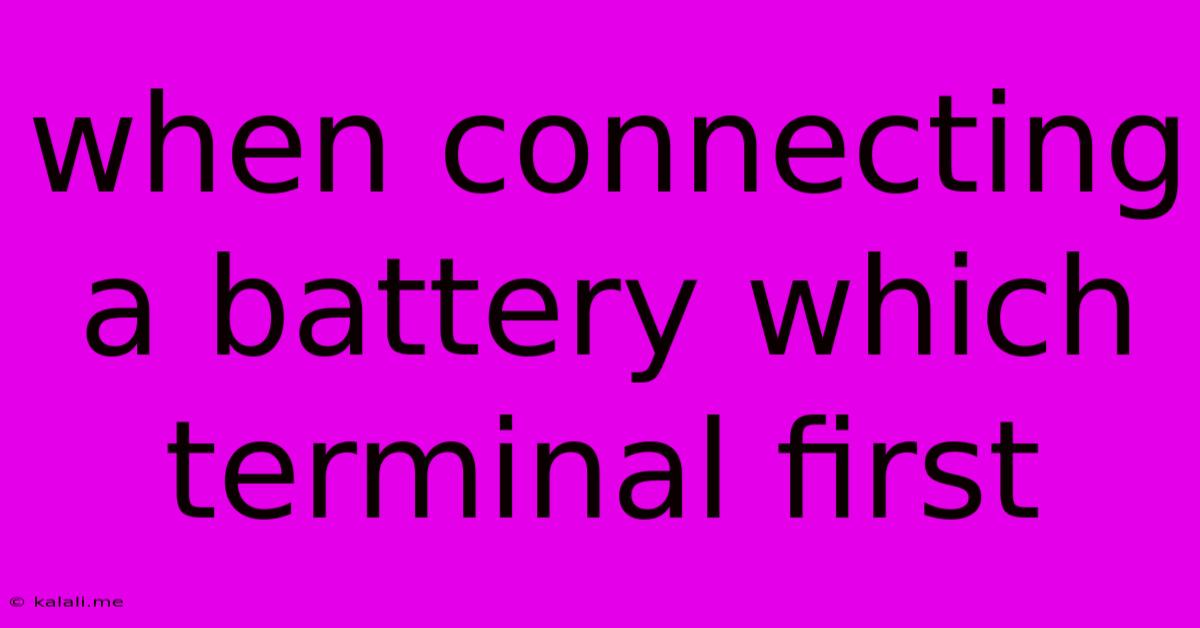When Connecting A Battery Which Terminal First
Kalali
May 20, 2025 · 3 min read

Table of Contents
When Connecting a Battery: Which Terminal First? A Guide to Safe Battery Connection
Connecting a battery incorrectly can lead to sparks, damage to your equipment, or even injury. Knowing the correct procedure is crucial for safety and ensuring the longevity of your battery and connected devices. This article will guide you through the proper steps, explaining why the order matters and offering helpful tips for various battery types.
Understanding Battery Polarity:
Batteries have two terminals: positive (+) and negative (-). These terminals are vital for the flow of electricity. Connecting them incorrectly creates a short circuit, potentially causing a dangerous surge of current. This can damage the battery, the device you're connecting it to, or even start a fire.
The Correct Procedure: Negative First, Positive Last (NFP)
The generally accepted and safest method is the Negative First, Positive Last (NFP) approach. This means you should connect the negative (-) terminal to your device first, and then connect the positive (+) terminal. When disconnecting, reverse the process: disconnect the positive (+) terminal first, then the negative (-) terminal.
Why NFP is Safer:
-
Reduced Risk of Short Circuits: Connecting the negative terminal first minimizes the chance of accidental contact between the positive terminal and conductive materials, thus preventing short circuits. If a positive lead accidentally touches a grounded metal surface, a spark may occur. If that lead isn’t connected to a positive post, the spark and any subsequent damage is minimized.
-
Minimized Spark Risk: If a short circuit does happen, connecting negative first often results in a smaller, less damaging spark.
-
Better Grounding: Connecting negative first grounds the circuit, which can further reduce the risk of sparks or damage.
Connecting Different Battery Types:
The NFP method applies to most battery types, including:
-
Car Batteries: Always use caution when working with car batteries due to their high amperage. Wear safety glasses and gloves.
-
Motorcycle Batteries: Similar safety precautions should be taken as with car batteries.
-
Small Batteries (e.g., AA, AAA, 9V): While the risk is lower, following the NFP method remains a good practice to avoid accidental short circuits.
-
Lithium-ion Batteries: These batteries require extra caution due to their potential for thermal runaway. Always consult the manufacturer's instructions for specific safety guidelines.
Important Safety Tips:
-
Inspect the Terminals: Before connecting the battery, inspect the terminals for any corrosion or damage. Clean them if necessary.
-
Use Insulated Tools: Use insulated tools to avoid accidental shocks.
-
Wear Safety Gear: Always wear safety glasses and gloves, especially when working with larger batteries.
-
Proper Ventilation: Ensure good ventilation when working with batteries, as some may release gases.
-
Consult the Manual: Always refer to the manufacturer's instructions for specific safety guidelines.
Conclusion:
Connecting a battery correctly is not just about functionality; it's about safety. The Negative First, Positive Last (NFP) method is the recommended procedure for minimizing risks. By following these guidelines and prioritizing safety, you can ensure a safe and successful battery connection every time. Remember, prevention is always better than cure when dealing with electricity.
Latest Posts
Latest Posts
-
Do You Integrate Acceleration To Get Velocity
May 21, 2025
-
Minimum Soil Depth For Grass Over Concrete
May 21, 2025
-
Can You Install Vinyl Over Vinyl
May 21, 2025
-
Find A File In Linux Recursive
May 21, 2025
-
Live By The Sword Die By The Sword Meaning
May 21, 2025
Related Post
Thank you for visiting our website which covers about When Connecting A Battery Which Terminal First . We hope the information provided has been useful to you. Feel free to contact us if you have any questions or need further assistance. See you next time and don't miss to bookmark.